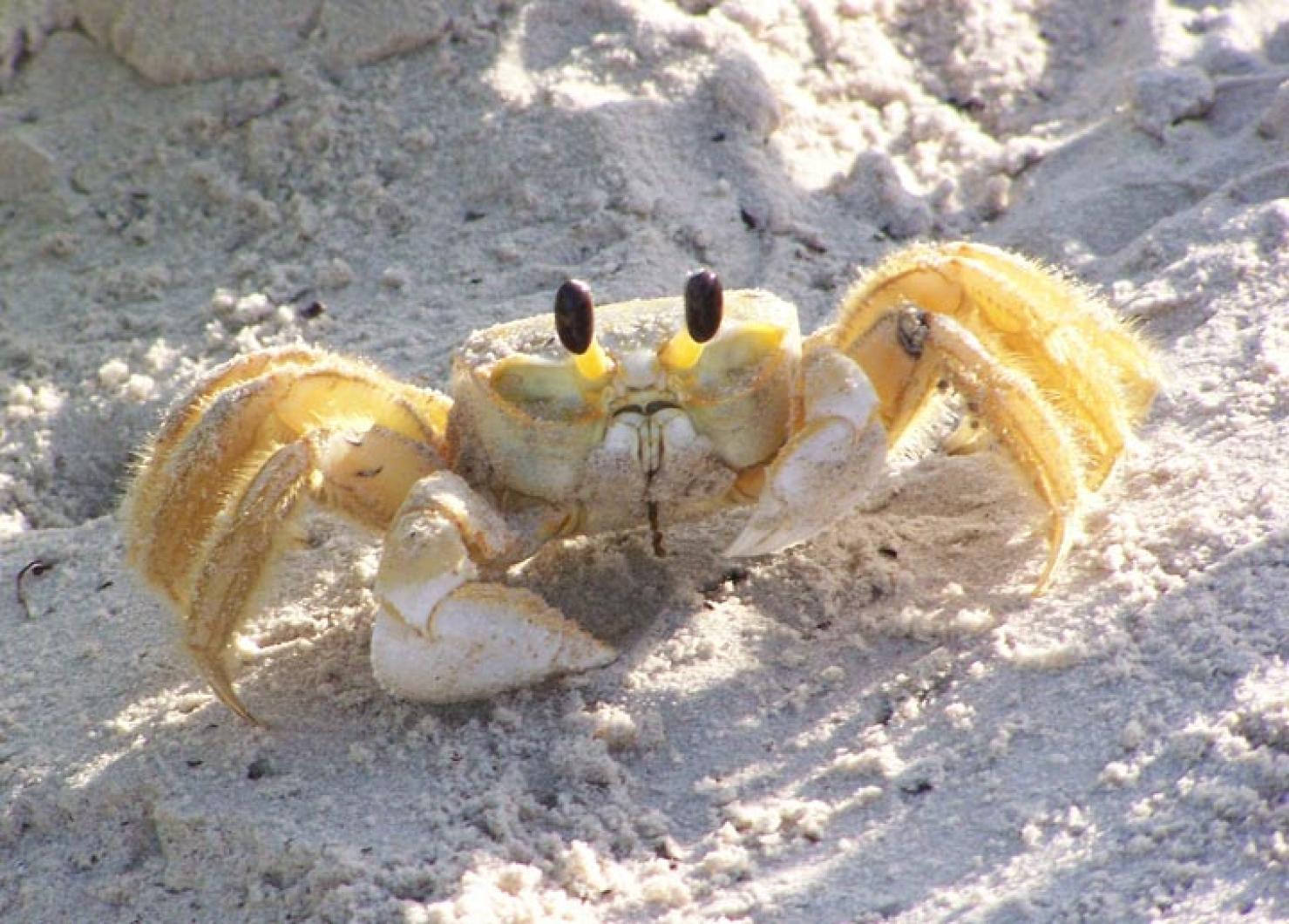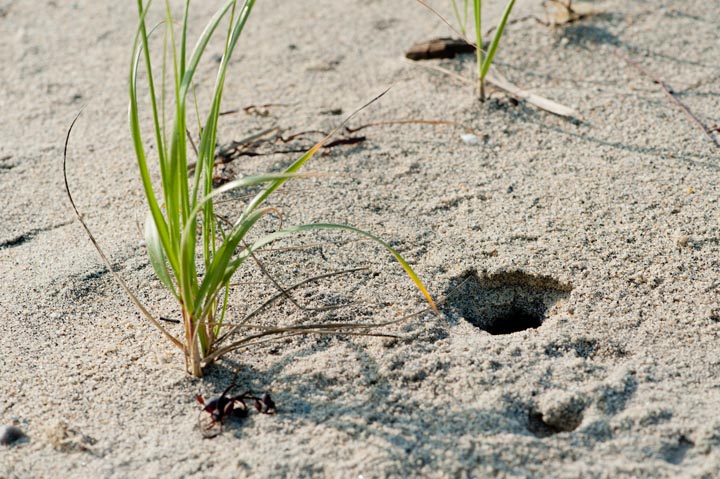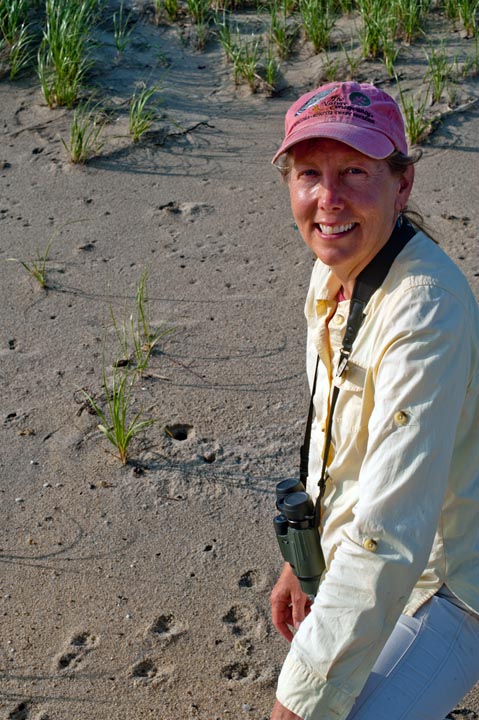They only come out at night, but their signature burrows can be seen along south-facing dunes on ocean beaches from Aquinnah to Edgartown. Given these habits, they have the perfect name: ghost crab.
Luanne Johnson, an Island biologist who wanders the beaches tracking coastal birds and other wildlife, has noticed a surge in ghost crab burrows along the south shore this spring.
Their apparent, sudden surge to more than 100, according to Ms. Johnson, suggests that perhaps the non-indigenous creatures are breeding here. If so, it will not only add another creature to the Island’s burgeoning list of beachfront life, but could alter the balance of that life. For example, there is evidence elsewhere on the East Coast that ghost crabs are predators of piping plover eggs.
Ghost crabs are far more common in mid-Atlantic and mid-tropical beaches. Their normal habitat runs along the shoreline of New Jersey, Delaware and North Carolina. There is some speculation that climate change might be one reason the ghost crab is expanding its range to more northern waters that are more temperate than they were in the past. But that is just conjecture at this point.
Ms. Johnson is quick to point out that she is not an authority on crabs, but sees this as an educational opportunity to alert those who wander and use local beaches for recreational purposes to be aware. Life on the Island’s beaches isn’t static, she said. There are changes underfoot.
The spotting of ghost crabs on Martha’s Vineyard for Ms. Johnson goes back at least a decade. She said she first noticed them while doing studies on otters, skunks and piping plovers. Noted Island naturalist and native Gus Ben David, who owns the World of Reptiles in Edgartown, saw them almost 40 years ago when he was director of the Felix Neck Wildlife Sanctuary.
“The first one I saw was in the late 1970s. At that time, I didn’t know we had them here. They are basically a southern crab,” said Mr. Ben David.
The carapace length is no more than an inch and a half. “You can’t believe how fast they move,” Mr. Ben David said. “They are a predator, a little devil. They feed on other small crabs. They feed on dead fish.” He said he has marveled at how quickly one can cross the floor. On the beach, the animal will burrow down almost as fast as the blink of an eye.
Ms. Johnson said she learned recently that farther south along the Atlantic seaboard, piping plovers and ghost crabs share a common turf, and that ghost crabs are aggressive and will feed on piping plover eggs and will chase chicks. She said this suggests the Vineyard piping plover population has yet another predator. “It is going to be interesting to see what impact more ghost crabs have here,” Ms. Johnson said.
Tom Chase, director of conservation strategies with The Nature Conservancy, has done a lot of field work on Vineyard beaches as well as interior lands. In the 1980s, when Mr. Chase worked at Long Point for the Trustees of Reservations as the property superintendent, he saw the familiar ghost crab burrows. “The huge burrows are unmistakable,” Mr. Chase said. The burrow looks like a deep hole in the sand. There is little disturbance near the hole.
Tim Simmons, a restoration ecologist with the state Natural Heritage and Endangered Species program, recalls watching them in the 1980s. “They were always small juveniles. But they are getting bigger and bigger. The question we wonder now is, ‘Are they living here from year to year, full cycle?’ ”
It was believed that the ghost crabs would arrive as juveniles by sea, where they first begin their lives as larva. But now Mr. Simmons said he wants to know if the population is established and breeding here.
“I suspect they are showing up on our beaches, living a year or two. But I want to know if they are breeding, having a full cycle here,” he said, adding: “I want to see if there are any females with eggs.” The easiest way to find out is to visit the beach at night and capture one, which will take some effort.
Mr. Simmons said the ghost crab is already appearing on the Cape.
Is this a sign of global warming? “I call it climate disruption.” Mr. Simmons said, adding that there is a list of different animals that have changed their range through the years, including mockingbirds, cardinals and red-bellied woodpeckers.
Mr. Chase said more science would be required to say this is a definite sign of global warming. “We are living in changing times. Even if they are not climactic, there are big things happening. Much is changing on the Vineyard. New plants and animals are being discovered all the time. I see surprises in the marine environment, in estuaries, in freshwater, land and in the air. New things are always being discovered,” he said.
Ms. Johnson agreed. “If an animal was going to spread its range, the south shore of Martha‘s Vineyard is a great place to begin,” she said. “We face due south. Whatever it is, they will bump right into it.”
For those enjoying the beach this summer, Ms. Johnson offered a thought: “Be mindful, be aware that there are things living on the beach. It is their home. Pay attention. You may notice them.”
She invited anyone who has seen or observed ghost crabs to let her know on her Facebook page, or by visiting biodiversityworksmv.org.






Comments (3)
Comments
Comment policy »